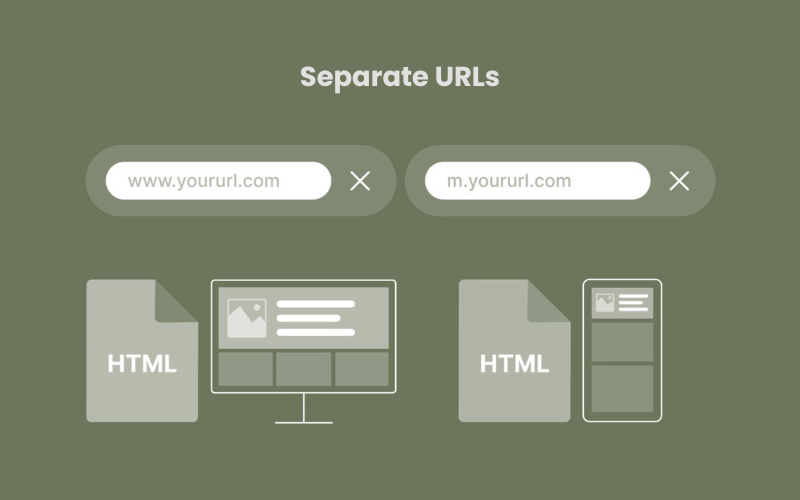Is your website ready for the mobile-first indexing era? Let’s talk mobile SEO and why it’s a big deal. With more than 60% of web traffic coming from mobile devices, optimizing for them is a no-brainer. And now that Google’s all in with mobile-first indexing, it’s not just about if you should do it but how well you’re doing it.
Enter Interaction to Next Paint (INP), the new kid on the SEO block since March 12, 2024, replacing First Input Delay (FID). Keeping up with these changes is key. But don’t worry, we’ve got your back with practical steps to boost your site’s mobile SEO game. Let’s make sure your site shines in the mobile spotlight!
What Is Mobile SEO?
So, Mobile SEO basically means tweaking your website to show up higher in search results when people are using their smartphones or tablets. It’s super important because more folks are searching on mobile now than ever before.
Now, don’t go thinking it’s a whole new ball game. A lot of the same rules that apply to desktop SEO still count here. But here’s the kicker: mobile search is booming. So, you gotta make sure your site is ready to roll on those smaller screens.
That means your design, your content—basically everything—needs to be on point for mobile users. Oh, and let’s not forget about keywords. When you’re optimizing for mobile, the words you’re gunning for might need a little shake-up too.
The Importance Of Mobile SEO
Did you know that more than 60% of the time when people search online, they’re doing it from their mobile phones? Yep, it’s true! And while mobile searches are going up, searches from desktop computers are actually going down.
Here’s another interesting stat: Google says that a whopping 56% of folks who shop in physical stores use their smartphones to look up stuff about products while they’re browsing the aisles. Crazy, right?
So, even if your store is bustling with customers walking in and out, you could still be losing out on potential business if you’re not paying attention to mobile SEO. It’s like leaving money on the table!
Google Uses Mobile-First Indexing
Google’s all about mobile-first indexing these days. That basically means your site’s mobile version is the main one Google considers for rankings. So, if you have both desktop and mobile URLs, Google will pick the one that suits the user best for search results.
Now, if your site isn’t optimized for mobile yet, don’t worry. I’ll walk you through how to get that sorted in the next section. Let’s make sure your site shines on mobile for that top SEO ranking!
3 Ways To Configure Your Website For Mobile
So, when you’re thinking about making your website mobile-friendly, you’ve got three choices:
- Responsive design
- Dynamic serving
- Separate URLs
Let’s kick things off with the simplest and most manageable option: responsive design.
Responsive Design
Here’s the deal with mobile SEO and responsive design—it’s like serving up a magic page that looks great whether you’re on your phone or your computer. How does it work? Well, the server sends out the same basic HTML every time, but the CSS swoops in to make it look just right for whichever device you’re using. Like this:

Why is this such a big deal for SEO? Let’s break it down for you:
- One URL Fits All: No more juggling separate URLs for mobile and desktop versions of your site. With responsive design, it’s all under one roof, making it easier for users to share and link to your content.
- Fewer Mobile Mishaps: Say goodbye to those awkward mobile site blunders. Responsive design cuts down on common mistakes, keeping your mobile experience smooth and glitch-free.
- Easy Peasy Maintenance: Who’s got time to constantly tweak separate mobile sites? Not you! Responsive design is a breeze to maintain compared to other methods, freeing up your schedule for more important stuff.
- Speedy Gonzales Load Times: No more waiting around for redirects to load properly. With responsive design, your site loads up fast and snappy on any device, keeping users happy and engaged.
- Google’s Stamp of Approval: Google’s on board with responsive design, and let’s be real, when Google talks, we listen. Using it can make your site a breeze for Google to crawl, saving you from redundant crawls and boosting your SEO mojo.
And here’s the cherry on top—responsive design means no more duplicate content headaches or pesky redirects slowing you down. You can whip up one responsive page for each piece of content and call it a day.
So, not only does it save you a boatload of time, but you can kiss those worries about how your site looks on different devices goodbye. It’s a total win-win for mobile SEO.
Dynamic Serving
What happens is, depending on what device you’re using, the website serves up different HTML without changing the URL. It’s like a chameleon website! For example:

But here’s the kicker: Google actually prefers something called responsive design. That’s when your site adjusts seamlessly to any screen size. Why? Well, with dynamic serving, there’s a risk of users getting the wrong version of a page. Imagine pulling up a site on your phone and seeing the desktop version instead. Talk about frustrating!
Google’s got a guide on dynamic serving that dives deeper into why they’re all about responsive design. Check it out if you want to know more about why they’re waving the responsive flag!
Separate URLs
So, another option on the table is creating separate URLs for your desktop and mobile sites. Essentially, you’ll have one URL for desktop and another for mobile, like https://www.yoursite.com/ for desktop and https://m.yoursite.com/ for mobile.
Like so:

But here’s the thing: Google isn’t a big fan of this method. Here’s why: When someone lands on your site, the server decides whether to send them to the mobile or desktop version. Sounds convenient, right? Well, not so fast. Managing two versions can be a real headache. Plus, you’ll need to slap on some rel=”canonical” or rel=”alternate” tags to each page’s HTML to tell Google which one is the main version.
Here’s the gist:
- On mobile pages, you need a rel=”canonical” tag pointing to the desktop version.
- On desktop pages, you need a rel=”alternate” tag pointing to the mobile version.
Miss out on these tags, and Google might see your mobile and desktop pages as duplicates. And that’s a recipe for confusion when Google tries to figure out which page to rank.
Long story short: Messing up these separate URLs could lead to a ton of time fixing SEO headaches you could’ve avoided, not to mention a hit to your Google ranking.
Mobile SEO Tips & Best Practices
Alright, now that we’ve got the basics down, let’s dive into the world of mobile SEO. Here are eight must-know tips and best practices to ace your mobile SEO game:
Create Mobile Friendly Content
Let’s talk about crafting mobile-friendly content that’s optimized for mobile SEO from the get-go:
Use Short Paragraphs
When you’re thinking about mobile SEO, remember that what looks like a short paragraph on your desktop might seem like a never-ending scroll on a mobile screen. So, to keep things clear and easy to digest, it’s smart to stick to one main idea per paragraph.
Now, there isn’t a strict rule about how many sentences you should have in each paragraph. But, generally, shorter paragraphs tend to work better for mobile users. Why? Because it’s less overwhelming to read on a smaller screen.
Another handy tip is to chop up long sentences into smaller ones. This helps mobile readers skim through your content more smoothly without getting lost in a sea of text.
If you really want to spice things up and make your content mobile-friendly, consider using bulleted or numbered lists, tables, images, or videos. These elements break up the text and keep your readers engaged, even on the tiniest screens.
Keep Introductions Short
It’s smart to keep your intros brief. Why? Because when people hit your site, they’re likely only seeing a snippet of what you’ve got. Your mission? Reel them in fast. Get straight to the point. You can dive deeper into the nitty-gritty as you go along.
And if your piece focuses on a question-based keyword, here’s the golden rule: Serve up the answer right off the bat. Let’s say someone’s Googling “how many ounces in a cup.” Boom! Give them the answer in that opening line. Easy peasy!
Don’t Be Afraid Of White Space
You know what’s super important in web design? White space! Yep, that’s the blank space you see between text, images, and all that jazz on a webpage. Turns out, it’s not just there for looks – it actually boosts readability big time.
So, picture this: when you’ve got some breathing room between all the stuff on a page, it makes it way easier for folks to understand what they’re reading or looking at. Studies even show that adding white space can crank up comprehension by a whopping 20%!
Plus, it’s like a navigation hack for the eyes – that extra space makes it a breeze to skim through headings and lines. So, if you’re aiming for better mobile SEO, don’t forget to embrace the beauty of white space!
Avoid Intrusive Pop-Ups
oogle has been cracking down on intrusive pop-ups for quite some time, especially when it comes to mobile SEO. Specifically, they’ve been calling out those annoying interstitial pop-ups that block the main content as soon as you land on a page. You know, the ones that cover up what you actually came to see? Yeah, those.
Now, there are some exceptions. It’s still okay to have pop-ups for things like cookie consent or age verification. And you can even throw in a regular ad, as long as it doesn’t take over the whole screen.
But here’s the deal: if you’re going to use pop-ups, use them wisely. Don’t go hiding your content behind a bunch of ads. Keep it clean, keep it purposeful, and you’ll stay in Google’s good books.
Use Structured Data On Your Mobile Website
Structured data helps Google grasp your content better, and schema markup is the language it speaks. Think of schema markup as the translator between your content and search engines.
Ever seen those search results with stars or reviews right there? That’s schema markup at work, turning plain snippets into snazzy ones.
Especially on mobile, where space is tight, these rich results steal the spotlight. With just one column of results, every extra detail pops.
So, if you’re gunning for more mobile traffic, harness the power of structured data. It’s your ticket to standing out in the crowded SERP space.
Target Voice Search-Friendly Keywords
About 65% of folks between 25 and 49 are using voice search on their phones pretty regularly.
So, it makes total sense to tweak your content to cater to these voice-searching peeps. Basically, you want to make sure your content matches how people actually talk when they’re asking their phone a question.
When people use voice search, they tend to be more laid-back and ask questions like they’re chatting with a buddy. So, instead of just short, snappy keywords, you wanna use longer, more conversational ones.
For instance, if someone’s typing on a computer, they might search for “buy Playstation 5”. But if they’re using voice search, they’re more likely to say something like “Where can I get my hands on a PlayStation 5?” See the difference?
Optimize Title Tags & Meta Descriptions For Mobile SERPs
A golden nugget for your mobile seo would be tweaking your title tags and meta descriptions can work wonders for your click-through rate (CTR).
First off, when it comes to mobile searches, stick to a title tag that’s between 50 and 60 characters. Why? Because Google has a habit of chopping off or rewriting titles that go over 70 characters, and you don’t want that.
Now, onto some nifty title tag tips:
- Focus on one main keyword.
- Don’t go overboard with keywords – keep it natural.
- Each page deserves its own unique title.
- Put the juiciest info upfront.
- And onto meta descriptions:
Keep these babies under 120 characters, especially for mobile users. If they’re too long, Google might snip them or rewrite them, and that’s no good for anyone.
So, stick to the 120-character rule. That way, whether folks are on their phone or computer, they can soak in your whole meta description.
Here’s some extra advice for mobile-friendly meta descriptions:
- Sum up what your page is all about.
- Switch it up – unique descriptions for each page.
- Sprinkle in that primary keyword.
- Add a little call to action or something that hooks the reader in.
And there you have it – a recipe for boosting your mobile SEO with killer title tags and meta descriptions. Happy optimizing!
Master Mobile Sitespeed For Better UX
Google is all about speed when it comes to mobile sites. They actually suggest that your site loads in less than a second for mobile users. Now, that’s a pretty tough benchmark to hit, but don’t worry, there are some handy free tools like Google’s PageSpeed Insights. It’s like your personal speedometer for your site on mobile, giving you the lowdown on how fast your site loads and offering up tips to rev it up.
But wait, there’s more! Here are a few quick tips to give your site that extra speed boost:
- Shrink those images: If you’re using WordPress, try out an image optimizer like Smush Image Compression. These little gems can significantly reduce your image file sizes, which means faster load times.
- Get cozy with browser caching: Google themselves recommend this trick to speed things up. It’s like pre-loading your site so it’s ready to go the moment someone clicks on it.
- Embrace the power of CDNs: CDNs (that’s Content Delivery Networks for the uninitiated) can work wonders, especially for images. They can make those page elements zip onto the screen 2-3 times faster than usual. Fasten your seatbelt, because your site’s about to get a turbo boost!
Final Word
Wrapping it up, mobile SEO isn’t just a trend—it’s the way of the future. With over 60% of web traffic coming from mobile devices, optimizing your site for mobile isn’t just a nice-to-have, it’s a necessity. And now, with Google fully invested in mobile-first indexing, the stakes are higher than ever.
But fear not! Our SEO Services is here to help you navigate these mobile waters with ease. From responsive design to structured data and everything in between, we’ve got the tools and expertise to ensure your site shines in the mobile spotlight.
So, let’s talk about how we can elevate your mobile SEO game and ensure your site not only meets but exceeds Google’s expectations. Don’t let your site get left in the dust—let’s make sure it’s ready to lead the pack in the mobile-first era!


[…] Optimize for Mobile […]